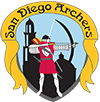Ever gone shooting down in Gold Gulch?
Ever gone shooting down in Gold Gulch?
The reference is not to some mythical mining town of the last century. Gold Gulch is located in the heart of San Diego, and field archery shooting is common there.
Gold Gulch is a winding canyon, lined with eucalyptus, live oak and sycamores, extending from southwest of the Girl Scout headquarters in the Park to the road that joins Balboa Park Bowl with the Cabrillo Freeway. The canyon can be approached either from the freeway a few blocks north of Ash Street or from the road by the refreshment stand at Park Boulevard and El Prado.
Named during the 1935 Exposition, when it was decked out like a street in the old Wild West, the Gulch has been the scene of a 28-target field archery course since 1939. The course was laid out by the San Diego Field Archers, a club which previously had functioned briefly in Mission Valley and which not only build the course, but has maintained it since, save for a period during the war when Balboa Park was closed by the military.
To the outside observer driving through this area, a dozen or so target butts — bales of hay wired together on which cloth or paper targets are affixed — make an appearance on hillsides or tucked back in shaded vales.
The remainder are scattered throughout a rough, but fascinating area that the local archers term “one of the most beautiful setups for field archery in the United States.” And not the least of the advantages of this course, members will tell you, is its amazing proximity to all points in this spread-out city.
The price for this archery facility has been one of endless hours of work on the part of the 70-member San Diego Field Archery Club. Target butts cost around 3 to 4 dollars and no few man hours to install, and wear and tear on these is a minor problem compared with that of vandalism by a constant stream of invaders on week days when the area is otherwise virtually deserted.
The unceasing efforts of archers to maintain their course testifies to their love of this sport, one any archer prefers to target archery on a lawn at standard distances. Field archers shoot at standard distances, too, so their scores can be compared with field archers throughout the country in competitions carried on by the National Field Archery Association.
But the resemblance to target archery ends there. Not only are field archery targets harder to bulls-eye because of varying heights and slanted terrain; they offer a continually changing problem for the archery with varying distances, angles, wind and footing.
Probably the greatest asset of field archery is its exercise value. Drawing the average 45-50 pound bow (28 pounds for women) takes a sturdy back, but covering some 3 miles of mountainous terrain 2 hours before lunch and 2 after during the course of a standard 56-target tournament requires sturdiness all over.
Field archers hold one of these tournaments on the third Sunday of each month. In addition, they meet for work parties or for business meetings at frequent intervals. Occasionally other unofficial tournament shoots are held, such as archery golf, battle clouts or tin-can rounds.
The local archers form a hale, gun-bronzed group, composed of an almost equal proportion of each sex and ranging considerably in age. They are particularly anxious to take in new members and to interest more people in this sport, one in which there still are a surprising number of amazingly skilled adherents in this post-Robin Hood atomic weapon age.
Two of the local members, Roy Dill and Frank Elcholz, have been national champions. There also are many beginners in the group, however.
Membership in the club is $6.50 a year or $9.50 for a man and wife. This includes membership in Southern California, State and National Archery Associations as well as a subscription to the magazine Archery.
Tournaments cost 50 cents per person which go for awards to winners. The average outfit for a starter, bows, arrows, quiver to hold arrows and an arm guard amounts to around $30.
Citation: https://sandiegohistory.org/archives/amero/balboapark/bp1950/
